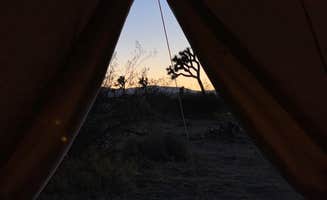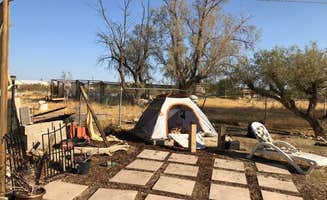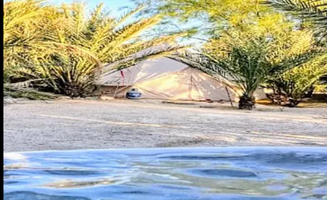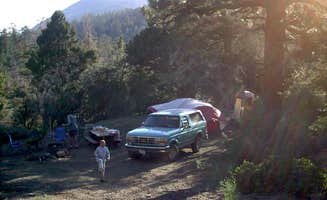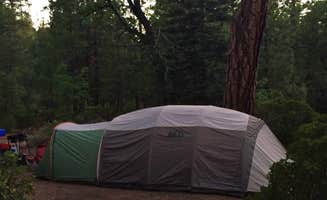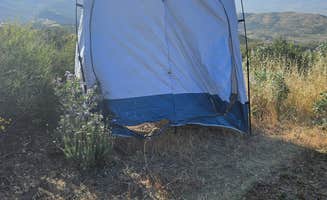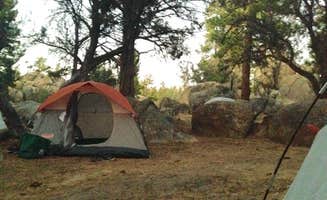Tent camping near Twentynine Palms, California ranges from primitive dispersed sites to established campgrounds at elevations between 1,200 and 4,000 feet. The Mojave Desert location experiences temperature swings of up to 40°F between day and night, with summer daytime highs regularly exceeding 100°F from June through September. Winter nights frequently drop below freezing, making fall and spring the optimal seasons for comfortable camping experiences.
What to do
Explore ladder canyons: Box Canyon Dispersed camping area provides access to unique geological formations where hikers can climb through narrow passages. A camper noted, "My favorite is the ladder canyon hike which has you climbing up a series of ladders in the canyon. Most of the time they are well maintained and replaced if they are falling apart, but beware just in case."
Wildlife observation: Dawn and dusk provide opportunities to observe desert wildlife. At Rancho Capotista, visitors can spot desert foxes, jackrabbits, and various bird species on the property. The open terrain provides clear sightlines for spotting animals moving across the landscape.
Geocaching adventures: Several camping areas contain hidden geocaches that provide an interactive treasure hunting experience. One visitor to Box Canyon Dispersed mentioned, "We had a great time. The kids did some exploring. Found a Geocache... we had two foxes come and visit the campsite."
Backcountry hiking: For experienced hikers with proper navigation tools, the area offers numerous backcountry routes. Register at backcountry boards before setting out, particularly if planning overnight treks from Boy Scout Trail access points.
What campers like
Night sky viewing: The dark skies create exceptional stargazing conditions with minimal light pollution. At Twentynine Palms, a camper shared, "Loved staying in twentynine palms to explore Joshua tree and the surrounding areas. Pioneer town was so fun. Headed in to Palm springs. Wow!"
Desert solitude: Many sites offer significant privacy and isolation from other campers. Simply Camping provides widely spaced sites that ensure quiet experiences. A visitor commented, "With all the sites being spread out, you'll have plenty of privacy. Pack it in, pack it out!"
Geological features: The eroded canyon walls showcase the region's geological history. A camper at Box Canyon noted, "Shear cliffs that are heavily eroded. Very distinct layers of floods. Nice hikes up thin canyons."
Accessible wilderness: Most primitive sites provide direct access to hiking trails without needing to drive to trailheads. This allows campers to explore directly from their sites without repositioning vehicles.
What you should know
Vehicle requirements: Many dispersed sites require appropriate vehicles. A recent visitor to Box Canyon warned, "This is ideally a good spot, but the sand is way too deep to get far enough off of the road."
Water planning: No reliable natural water sources exist in the area. All campers must bring sufficient water for drinking, cooking, and basic hygiene. Most primitive sites require 1-2 gallons per person per day depending on temperatures.
Navigation challenges: Cell service is inconsistent throughout the region. Physical maps are recommended as GPS applications may not function in remote areas. Trail markings can be minimal or non-existent in backcountry areas.
Seasonal considerations: Winter nights regularly drop below freezing while summer days frequently exceed 100°F. One camper at Black Rock Equestrian Campground advised, "Almost all sloped but not awful. Lot gets regularly graded. Central water location so you do have to schlepp your water to the corrals."
Tips for camping with families
Safety precautions: Establish clear boundaries for children due to potential hazards including steep drop-offs and wildlife. Bring comprehensive first aid supplies as medical facilities can be 30-45 minutes away.
Entertainment options: Pack items for entertainment during midday heat when outdoor activities may be limited. Board games, books, and shade structures help manage the hottest hours between 11am and 4pm.
Timing considerations: For the best tent camping near Twentynine Palms, California with children, schedule visits during spring or fall. One family that visited Boy Scout Trail Backcountry Sites noted it offers "guaranteed camping during busy weekends" but warned there are "No facilities along the trail (just the bathroom in the parking lot)."
Wildlife education: Prepare children for potential wildlife encounters by teaching identification and proper responses. Scorpions, rattlesnakes, and various reptiles inhabit the region and may be active during warmer months.
Tips from RVers
Site selection: RVs should carefully scout tent camping areas before attempting to navigate sandy terrain. According to a visitor at Box Canyon Dispersed, "Pretty sandy - would recommend 4wd but I suspect you could get in without. Got my jeep deep into the canyon between coachella weekends and was the only person there."
Resource management: RVers should plan for complete self-sufficiency. No dump stations or hookups exist at most primitive sites near Twentynine Palms. Bring sufficient water, power, and waste storage capacity for your entire stay plus an extra day.
Temperature control: RVs need effective insulation and ventilation strategies for desert camping. Window reflectors, awnings, and portable fans help manage temperature extremes that can make sleeping difficult.


